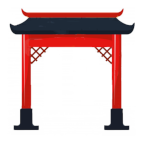|
|
是
|
 |
|
JLPT HSK 1 |
|
| correct, indeed, to be:am/is
|
Top: sun 日, bottom: correct 正 (To stop 止 at the line 一 is correct.)
The sun looks correct: This is indeed correct!

|
|
|
|
题
|
 |
|
JLPT HSK 2 |
|
| topic, problem for discussion, subject, to inscribe
|
Left: correct, indeed 是 (sun 日, correct 正), right: page, leaf 页 (=頁 head 目 with shoulders 八 and eyebrows 一)
The correct head is the topic of the discussion.

|
|
|
|
正
|
 |
|
JLPT HSK 2 |
|
| correct, just (right), straight, principle
zhēng, zhèng
止
正
 |
|
Top: a line 一, bottom: to stop 止 (image of the right foot that stops at a line 一)
To stop at the line is correct.

|
|
|
|
蛋
|
 |
|
JLPT HSK 2 |
|
| egg, oval shaped
|
Top: correct 正 (To stop 止 at the line 一 is correct, - actually 疋 = bales of cloth), bottom: insect 虫 (The body 口 and the sting 厶 of an insect.)
It is correct for insects to lay: eggs.

|
|
|
|
提
|
 |
|
JLPT HSK 3 |
|
| to carry/hold in a hand (suspended), to lift, to raise
|
Left: hand 扌, right: correct/indeed 是 (The sun 日 is correct 正) [And it is correct 正 to stop 止 at the line 一]
The hand is 'correct' for carrying sth.

|
|
|
|
楚
|
 |
|
JLPT HSK 3 |
|
| clear, orderly, distinct, pain, suffering
|
Top: forest 林 (= two trees 木), bottom: correct 正 [actually bales of cloth 疋] (the correct foot 止 stops at the line 一)
The forest is correct if it is clear and orderly.

|
|
|
|
定
|
 |
|
JLPT HSK 3 |
|
| to set, to fix, to determine, to order, surely
|
Top: roof 宀, bottom: var. of correct 正 (To stop 止 at the line 一 is correct.)
Under the roof, everything is o.k. if things are set and determined.

|
|
|
|
证
|
 |
|
JLPT HSK 4 |
|
| certificate, proof, to demonstrate, to confirm
|
Left: word 讠/言 (sound waves out of a mouth 口), right: correct 正 (To stop 止 at the line 一 is correct.)
Words that are correct are confirmed in a certificate.

|
|
|
|
整
|
 |
|
JLPT HSK 4 |
|
| in good order, exactly, to repair, to punish
|
Top: imperial order 敕 (It comes in a bundle 束 and strikes 攵: the imperial order) [to strike 攵=攴=hand 又 with stick卜], bottom: correct 正
(In linen production, the flax fibers are aligned by beating:) The bundle needs strikes, but correctly for (good) order.

|
|
|
|
疑
|
 |
|
JLPT HSK 4 |
|
| to doubt, to misbelieve, to suspect
|
Left: sitting person 匕, arrow 矢; right: bent person マ, correct 正
The sitting person with the arrow and the bent person are right with their doubt.

|
|
|
|
匙
|
 |
|
JLPT HSK 4 |
|
| spoon
|
Left: correct 是 (sun 日, variant of correct 正), right: spoon 匕 (sitting person and eating)
It is correct: this is a spoon.

|
|
|
|
征
|
 |
|
JLPT HSK 5 |
|
| campaign, impose (taxes), expedition, evidence
|
Left: go 彳, right: correct 正 (To stop 止 at the line 一 is correct.)
To "go ahead correctly", that's how to make a campaign or expedition.

|
|
|
|
政
|
 |
|
JLPT HSK 5 |
|
| politics, government
|
Left: correct, proper 正 (To stop 止 at the line 一 is correct), right: to strike 攵/攴 (hand 又 with stick 卜)
A proper strike is essential in politics.

|
|
|
|
武
|
 |
|
JLPT HSK 5 |
|
| martial, military
|
Left: correct 正 (To stop 止 at the line 一 is correct.), right: saber 弋
Correct sabers belong to: the military.

|
|
|
|
歪
|
 |
|
JLPT HSK 5 |
|
| at a crooked angle, devious, noxious, askew
|
Top: not 不 (Four strokes are not enough!), below: correct, right 正 (To stop 止 at the line 一 is correct.)
If sth. is not correct, it is crooked.

|
|
|
|
延
|
 |
|
JLPT HSK 5 |
|
| to spread, extend, to prolong, to delay, defer
|
Left: movement 廴, right: correct 正 (To stop 止 at the line 一 is correct)
Movement is correct (= is needed) to spread.

|
|
|
|
蔬
|
 |
|
JLPT HSK 5 |
|
| vegetables
|
Top: gras, plant 艹, bottom: scatter, sparse 疏 (It is correct 正, that newborn babies  [= child 子 upside down & amniotic fluid 川] scatter sparsely.) [= child 子 upside down & amniotic fluid 川] scatter sparsely.)
The plants that are scattered are the (eatable) vegetables.

|
|
|
|
嚏
|
 |
|
JLPT HSK 5 |
|
| sneeze
|
Left: mouth 口, right: fall, stumble 疐 (Person 十 falling from a roof 冖 into a field 田, but correctly 正/疋)
Out of the 'mouth' is falling sth., when sneezing.

|
|
|
|
症
|
 |
|
JLPT HSK 6 |
|
| illness, disease, symptom
zhēng, zhèng
疒
正
 |
|
Outside: illness/disease 疒 (An ice-冫-cold building 广 makes sick), below: correct 正 (To stop 止 at the line 一 is correct)
This disease is a correct/real disease.

|
|
|
|
惩
|
 |
|
JLPT HSK 6 |
|
| to punish, to reprimand, to warn
|
Top: campaign 征 (Go 彳 correctly 正 for the campaign), bottom: heart 心
Proceed correctly, but also with heart, when you have to punish.

|
|
|
|
疏
|
 |
|
JLPT HSK 6 |
|
| scatter, sparse, scanty, neglect, thin, to dredge
|
Left: 疋 (here: correct 正), right: 㐬 ("newborn baby" as a child turned upside down  : the child 子 comes with head first, with amniotic fluid 川) : the child 子 comes with head first, with amniotic fluid 川)
(Declining birth rate) It is correct that newborn babies are scattered sparsely.

|
|
|
|
凝
|
 |
|
JLPT HSK 6 |
|
| to congeal, coagulate, to gaze/stare at sb.
|
Left: ice 冫, right: doubt 疑 (Both persons 匕, マ with the arrow 矢 are correct 正 in their doubts.)
Ice is without doubt congealed.

|
|
|
|
旋
|
 |
|
JLPT HSK 6 |
|
| to revolve, a loop, a circle, whirl, return
|
Left: side, direction 方, right: horizontal person  , var. of correct 正. (When sleeping, one must occasionally turn to the other side to avoid pressure & bed sores & circulation problems.) , var. of correct 正. (When sleeping, one must occasionally turn to the other side to avoid pressure & bed sores & circulation problems.)
The side of the lying person is fine/correct, but he must turn.

|
|
|
|
堤
|
 |
|
JLPT HSK 6 |
|
| dike, dam, embankment
|
Left: earth 土, right: correct 是 (sun 日, variant of correct 正)
The earth is correctly (used) for a dike.

|
|
|
|
丐
|
 |
|
JLPT HSK 6 |
|
| to beg for alms, beggar
gài
正
 |
|
Correct 正 with a hook 亅
His actions are correct, but like with a hook he gets people's money: The beggar.

|
|
|
|
钙
|
 |
|
JLPT HSK 6 |
|
| calcium (chemistry, Ca)
|
Left: metal 钅, right: beggar, alms 丐 (His actions are correct 正, but like with a hook 亅 he gets people's money: The beggar.)
(An alkaline earth metal, but not silvery). The metal for poor people/beggars, is the calcium.

|
|
|
|
淀
|
 |
|
JLPT HSK 6 |
|
| sediment, deposits, precipitate
|
Left: water 氵, right: to settle, to fix 定 (Under the roof 宀, everything is correct 正, if things are settled.)
For water that is covered, it is correct (normal) to form a sediment.

|
|
|
|
赋
|
 |
|
JLPT HSK 6 |
|
| taxation, bestow on, endow with, poetic essay
|
Left: money 贝/貝, right: military 武 (correct 正 sabers 弋 for the military)
The money for the military are the: taxes.

|
|
|
|
怔
|
 |
|
JLPT no HSK |
|
| terrified, to stare blankly, startled
|
Left: feeling 忄, right: correct 正 (To stop 止 at the line 一 is correct.)
The feeling that I have to do it (always absolutely) correctly, is being: terrified.

|
|
|
|
焉
|
 |
|
JLPT no HSK |
|
| where, how
|
Top: correct 正, bottom: variation of bird 鳥 (without head)
Is it correct, that this bird has no head: How? Where?

|
|
|
|
婿
|
 |
|
JLPT no HSK |
|
| son-in-law
|
Left: woman 女, right: 胥 (var. of correct/proper 正, body 月/肉)
The woman wants a "proper body" as son-in-law.

|
|
|
|
绽
|
 |
|
JLPT no HSK |
|
| to burst open, rend, open seam
|
Left: thread 纟/糸, right: to settle, to determine 定 (Under the roof 宀, everything is correct 正, if things are settled.)
(When the tension becomes too big:) The thread determines when it will burst open.

|
|
|
|
嫣
|
 |
|
JLPT no HSK |
|
| beautiful, sweet, captivating, engaging
|
Left: woman 女, right: where, how 焉 (Is it correct 正, that the bird 鳥 has no head: How? Where?)
The woman does it correctly when being like a bird: captivatingly beautiful.

|
|
|
|
胥
|
 |
|
JLPT no HSK |
|
| all, together, mutually, assist, to store
|
Top: correct 正 (To stop 止 at the line 一 is correct), below: bodypart 月/肉
The correct bodies assist each-other mutually.

|
|
|
|
漩
|
 |
|
JLPT no HSK |
|
| eddy
|
Left: water 氵, right: turn, revolve 旋 (The side 方 of the lying person  is okay 正, but he has to be turned [because of bed sores?]) is okay 正, but he has to be turned [because of bed sores?])
Water, that revolves is an eddy.

|
|
|
|
罡
|
 |
|
JLPT no HSK |
|
| stars of the Big Dipper
|
Top: 罒 (here: 3 stars ロ next to each other), bottom: correct 正 (To stop 止 at the line 一 is correct)
The three (stars) are correct if the show the: Big Dipper.

|
|

 [= child 子 upside down & amniotic fluid 川] scatter sparsely.)
[= child 子 upside down & amniotic fluid 川] scatter sparsely.) , var. of correct 正. (When sleeping, one must occasionally turn to the other side to avoid pressure & bed sores & circulation problems.)
, var. of correct 正. (When sleeping, one must occasionally turn to the other side to avoid pressure & bed sores & circulation problems.)